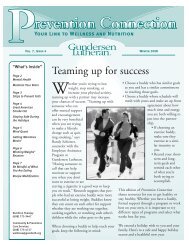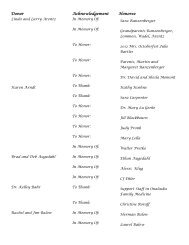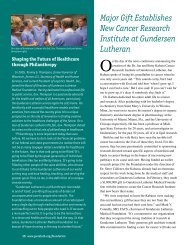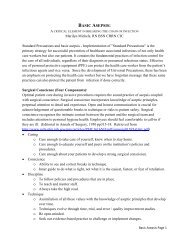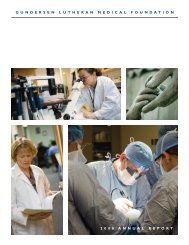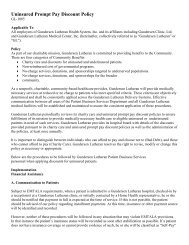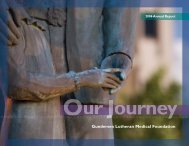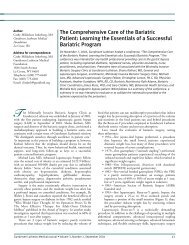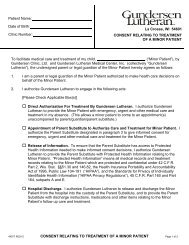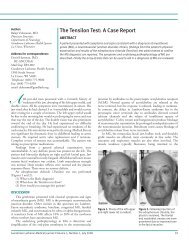Streptococcus bovis - Gundersen Lutheran Health System
Streptococcus bovis - Gundersen Lutheran Health System
Streptococcus bovis - Gundersen Lutheran Health System
You also want an ePaper? Increase the reach of your titles
YUMPU automatically turns print PDFs into web optimized ePapers that Google loves.
amputation.” 4 Given that a lot of these procedures were performed<br />
in fields or stables, it comes as no surprise to find gangrene, sepsis,<br />
hemorrhage, and tetanus as constantly dreaded complications<br />
associated with these operations. 4,5<br />
Postamputation pain<br />
Along with the lack of pain control during the amputation,<br />
the phenomenon of postamputation pain has been recognized<br />
for many centuries. Admiral Lord Nelson lost his right arm at an<br />
attack on Santa Cruz de Tenerife. 6 Not only was the amputation<br />
in itself quite challenging, but imagine the difficulty of performing<br />
this under a most compromised situation, namely, on a moving<br />
battleship, with little space, in the semi-darkness of the ship’s<br />
interior. Admiral Nelson, who barely survived hypothermia and<br />
considerable blood loss, found himself in tremendous pain after he<br />
survived the amputation of his arm—in the amputated arm! He<br />
found the emergence of painful phantom sensations to be proof of<br />
the existence of the soul, given that an extremity that was no longer<br />
there could hurt so much. Fortunately, a second operation, which<br />
likely relieved an inadvertently placed suture on the median nerve,<br />
relieved most of his pain and restored him to function. However,<br />
through the ages, a significant percentage of amputees could not<br />
be delivered from their torturous pain. 7,8<br />
S. Weir Mitchell, who is considered the Father of American<br />
Neurology, wrote a short story, “The Case of George Dedlow,”<br />
in 1886. 9 The central character, George Dedlow, progressively<br />
loses all 4 extremities and is befallen by phantom limb pain: “I<br />
was suddenly aware of a sharp cramp in my leg. I tried to get at it<br />
to rub it with my single arm, but finding myself too weak, hailed<br />
an attendant: ‘Just rub my left calf,’ said I, ‘if you please.’ ‘Calf?’<br />
said he. ‘You ain’t none, pardner. It’s took off.’ ‘I know better,’ said<br />
I. ‘I have pain in both legs.’ ‘Wall, I never!’ said he. ‘You ain’t got<br />
nary leg.’” In this story, George Dedlow becomes the symbol for<br />
the cost of the Civil War, which left 500 000 soldiers disfigured,<br />
disabled, and in chronic pain. 10<br />
Erich Maria Remarque described in his classic novel All Quiet on<br />
the Western Front the sufferings endured by the generation involved<br />
in the atrocities of trench warfare in World War I. 11 Standing at<br />
the bedside of his severely injured friend, Franz Kemmerich,<br />
Albert Kropp asks, “How goes it Franz?” “Not so bad…but I have<br />
such a damned pain in my foot.” The leg has been amputated.<br />
With more than one meaning, Kropp commends, “Now you will<br />
soon be going home.” During the next visit, Franz is dying from<br />
complications of the amputation. He gives his “good army boots”<br />
to his friend Müller, also giving hope to go on fighting not only a<br />
war, but also the adversities in life.<br />
Ambroise Paré (1510-1590) described phantom pain in<br />
a surprisingly comprehensive fashion. 12 He differentiated<br />
preamputation pain from postamputation symptoms, and stump<br />
pain from phantom sensations and phantom limb pain. Paré<br />
recognized a psychological component in pain perception, as well<br />
as pain-alleviating and pain-modulating modalities.<br />
Paré’s tract was geared toward his surgical colleagues who were<br />
familiar with the challenges of treating postamputation pain.<br />
Paré rejected the use of multiple limb-shortening procedures for<br />
persistent pain and advocated for early amputation of necrotic<br />
limbs and nonsurgical treatment of phantom pain as a combination<br />
hiStoriCAL noteS on AMputAtion And phAntoM LiMb pAin<br />
figure 2. Ambroise Paré (1510-1590), French barber surgeon<br />
credited with the first detailed description of phantom limb pain.<br />
Courtesy of the National Library of Medicine.<br />
of massage therapy for the stump and neck and the use of an<br />
antispasmodic ointment. Paré used 2 neurological models to<br />
explain phantom sensation/pain: (1) A peripheral model focused<br />
on contractures of muscles, nerves, and tendons; contractures<br />
postinjury were commonplace in his era and, therefore, widely<br />
recognized; and (2) A central nervous system model that identified<br />
“pain memory” as the cause of pain without contractures.<br />
Silas Weir Mitchell, a 19th-century neurologist, is credited<br />
with coining the term phantom limb and the first concise description<br />
of the phantom pain phenomena, 13-15 though Charles Bell, a<br />
British physician, had also described phantom limb sensations in<br />
1830 in his monograph The Nervous <strong>System</strong> of the Human Body. 16,17<br />
Guéniot 18 described in an 1861 tract About Hallucination of<br />
Feeling in Certain Amputees, the phenomenon of regressive<br />
deformation, also known as telescoping. Telescoping refers to<br />
the process of shrinking of the phantom sensation as the digits<br />
become approximated to the stump, a phenomenon that seems<br />
more likely to occur in the arm than in the leg. It is a gradual<br />
process that occurs in 25% to 75% of amputees and is usually<br />
complete after the first year. Pain, recurrent trauma, and other<br />
similar events can reverse this process.<br />
Since these original descriptions, phantom limb phenomena<br />
have also been described with multiple other organ extirpations,<br />
such as the tongue, penis, testicle, breast, bladder, gallbladder, and<br />
teeth, as well as with spinal cord and nerve avulsion injuries. Bors<br />
described in 1951 phantom pain associated with spinal cord injury<br />
<strong>Gundersen</strong> <strong>Lutheran</strong> Medical Journal • Volume 6, Number 1, June 2009 27






